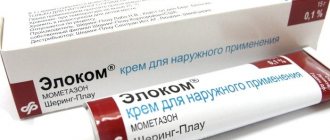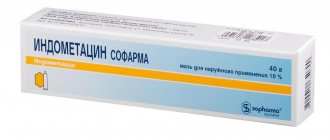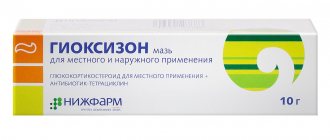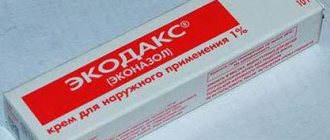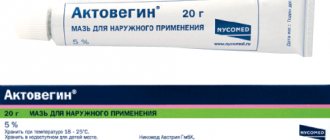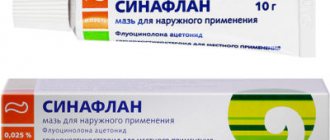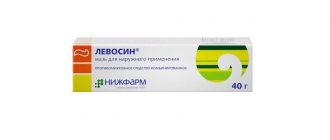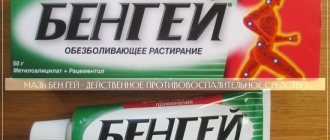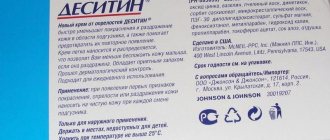Composition and release form
Betadine is a thick dark brown ointment with a distinct iodine odor. It is quickly absorbed by the wound surface and exhibits therapeutic properties after a few minutes.
The Hungarian manufacturer packages it 20.0 g in white aluminum tubes with a red stripe. The secondary packaging for the product is a cardboard box, inside of which there is instructions for Betadine ointment.
The active ingredient is povidone-iodine from the clinical-pharmacological group of antiseptics. And the auxiliary composition is represented by the following components:
- macrogol;
- sodium bicarbonate;
- purified water.
One of the forms of release of the drug
The ointment contains no fatty components, which explains its good absorption into the tissue. Auxiliary ingredients ensure the maximum possible penetration of povidone-iodine into inflammatory lesions. Thus, they enhance and prolong the action of the main component.
The therapeutic line of Betadine in pharmacies is also represented by a solution and suppositories for vaginal administration. These dosage forms are used in dermatology, gynecology, and obstetric practice.
Pharmacological properties
Povidone-iodine provides all the therapeutic effects of Betadine. It is a high molecular weight complex containing iodine in bound form. Upon contact with wound surfaces, it is gradually and evenly released. In its free form, iodine is a powerful antiseptic. Under its influence, cells of pathogenic microorganisms - bacteria, protozoa, fungi, and some types of viruses - are quickly destroyed.
Even after a single use of the ointment, the condition of the wounds improves significantly:
- inflammatory processes weaken and then stop;
- the intensity of pain, burning, itching decreases;
- swelling resolves;
- the spread of the infectious process to healthy areas of the skin and mucous membranes stops;
- blood circulation is accelerated, and, consequently, the restoration of damaged tissues.
The ability of free iodine to destroy special proteins - the building material of the membranes of infectious agents - has been proven. This makes the cell easily permeable to fluid, so it collapses within a few minutes. Pathogenic bacteria and fungi lose their ability to reproduce and soon die.
Povidone-iodine is the main active ingredient that provides antiseptic effects
Drug interactions Betadine
The simultaneous use of povidone-iodine and hydrogen peroxide, as well as enzyme preparations containing silver and tauloridine, for the treatment of wounds or antiseptic drugs, leads to a mutual decrease in effectiveness, and therefore their combined use is not recommended. Povidone iodine should not be used with mercury preparations due to the risk of formation of alkaline mercury iodide. The drug can react with proteins and unsaturated organic complexes, so the effect of povidone-iodine can be compensated by increasing its dose. Long-term use of the drug should be avoided, especially on large surfaces, in patients using lithium preparations.
Indications for use
Betadine is used in the treatment of inflammatory skin lesions, the development of which is provoked by pathogenic microorganisms. The ointment is prescribed to patients when infectious pathogens are detected that have not developed resistance to iodine.
Various allergic reactions, including severe ones, respond well to treatment with it. The drug copes well with their leading symptoms: itching, pain, rashes.
Betadine ointment - what it helps with:
- trophic ulcers, especially those with a low tendency to heal and a tendency to recur;
- any lesions of the skin and mucous membranes caused by the introduction of gram-positive or gram-negative bacteria;
- activation of pathogenic fungi, which caused skin trauma;
- exacerbation of herpes infection with local clinical manifestations;
- viral skin lesions.
Betadine is prescribed, including for severe manifestations of skin allergies.
One of the indications for the use of Betadine ointment is diabetic foot. This is the name given to specific anatomical and functional changes in the tissues of the lower leg. The pathology is difficult to treat due to metabolic disorders. The effectiveness of Betadine ointment in the treatment of diabetic foot has long been confirmed in practice.
The drug has proven itself in the treatment of bedsores - soft tissue necrosis resulting from prolonged pressure. It quickly copes with infected wounds, including punctures, cuts, burns, abrasions, and frostbite.
Some dermatologists prescribe it to patients with papillomas. Iodine coagulates, as if cauterizes these neoplasms, so their size gradually decreases. The ointment is also in demand in the treatment of acne, especially those accompanied by severe inflammation.
Ointment is prescribed for the treatment of foot fungus
Side effects of the drug Betadine
Allergic skin reactions - itching, hyperemia, rash (contact dermatitis with the formation of psoriasis-like elements). In some cases, generalized acute reactions with a decrease in blood pressure and/or suffocation (anaphylactic reactions) are possible. In some cases, iodine-induced hyperthyroidism has been observed in predisposed individuals. Application of povidone-iodine to large wounds or severe burns can cause adverse effects, such as changes in serum electrolyte levels (hypernatremia) and osmolarity, metabolic acidosis, renal dysfunction, and even acute renal failure.
Contraindications
An absolute contraindication to the use of the drug is thyrotoxicosis. This is a clinical syndrome caused by increased hormonal activity of the thyroid gland. It is characterized by excessive production of thyroid hormones. Therefore, iodine from Betadine will cause a person to feel worse.
The use of the drug is strictly prohibited in the presence of the following pathologies:
- thyroid adenomas formed from thyroid tissue;
- Dühring's dermatitis herpetiformis, manifested by a polymorphic rash.
The drug is contraindicated if the patient is undergoing treatment with radioactive iodine. It is not prescribed to patients with individual intolerance to one of the ingredients of the drug. Relative contraindications include severe pathologies of the urinary organs, including renal failure.
Pregnancy and lactation
The active ingredient, although in small quantities, still penetrates the bloodstream. There is a possibility of its accumulation in breast milk. Therefore, the use of Betadine during lactation is undesirable.
If necessary, the external agent is used in the 1st trimester of pregnancy. Doctors prescribe it to women when safer options have not had the desired effect. At later stages of pregnancy, treatment with the drug is prohibited.
Pregnant women can use the product only in the early stages
Childhood
The research results confirmed the safety of using the product in pediatric practice. But there are also exceptions. The ointment is not used in the treatment of newborns and premature infants.
Overdose of the drug Betadine
Acute iodine intoxication is characterized by the following symptoms: metallic taste in the mouth, increased salivation, heartburn, pain in the mouth or throat; irritation and swelling of the eyes; skin reactions; gastrointestinal disorders; renal dysfunction, anuria; circulatory failure; laryngeal edema with secondary asphyxia, pulmonary edema, metabolic acidosis, hypernatremia. Long-term treatment of burn wounds with significant amounts of povidone-iodine can provoke an imbalance of electrolyte balance or serum osmolarity with impaired renal function or metabolic acidosis. Treatment: provide supportive and symptomatic therapy under the control of electrolyte balance, renal and thyroid function. In case of intoxication caused by ingestion of the drug, immediate administration of foods containing starch or protein (for example, starch solution in water or milk), gastric lavage with 5% sodium thiosulfate solution or, if necessary, intravenous administration of 10 ml 10 % sodium thiosulfate solution at 3-hour intervals. Monitoring of thyroid function is indicated for early detection of iodine-induced hyperthyroidism.
Instructions for use
According to the instructions for use of Betadine ointment, you can use it only as prescribed by a doctor. Single and daily doses, duration of treatment are determined by a dermatologist or traumatologist. It takes into account the type of disease, the intensity of the inflammatory process, and the severity of symptoms.
How to use external remedy:
- first wash the skin with warm water and soap, dry;
- if necessary, remove dead tissue from the wound;
- Spread a thin layer of ointment on its surface, do not rub.
The product is applied to the skin in a thin layer, without rubbing.
The drug is used up to 3 times a day, in the form of occlusive dressings - no more than 2 times a day. The duration of the therapeutic course varies from 1 to 2 weeks. If necessary, the doctor extends it.
Overdose
In clinical practice, no cases of overdose have been observed due to the metabolism of the ingredients in the area of application of Betadine.
Side effects
If you are hypersensitive to the ingredients of Betadine, a local allergic reaction may develop. Its leading symptoms are rash, itching, pain, burning, swelling and irritation of the mucous membranes. The ointment must be washed off and then consult a doctor for symptomatic treatment. Allergic manifestations require discontinuation of the drug.
special instructions
Betadine stains the skin and mucous membranes a light brown color. While it persists, the bactericidal activity of the drug also manifests itself. This means that iodine is released and gradually destroys infectious pathogens. The less it remains in the tissues, the lighter the color becomes.
With long-term treatment, a decrease in the functional activity of the thyroid gland is sometimes observed. The cause is the reabsorption of iodine. Betadine is discontinued in such cases to prevent systemic side effects.
When using, be aware that the product leaves marks on the skin.
You should consult a doctor if the wound does not improve after a week of using Betadine. The doctor will determine a different dosage regimen and, if necessary, prescribe auxiliary agents. He can also replace Betadine with a drug with a different active ingredient.
Storage conditions and periods
The shelf life of the antimicrobial agent is 3 years. It should be stored at room temperature out of direct sunlight. Young children's access to Betadine should be limited. If the ointment separates, changes color or smell, it cannot be used for treatment.
Conditions for dispensing from pharmacies
When purchasing any dosage form of Betadine, you do not need to show the pharmacy employee a prescription from a doctor.
Drug interactions
The drug is pharmaceutically incompatible with disinfectants containing mercury. On the official website of Betadine, it is prohibited to combine it with oxidizing agents, alkali salts and substances with an acidic reaction.
Expert opinion
Lyudmila Sheveleva, pharmacist
Betadine often becomes the first choice drug in the treatment of infected wounds. This antiseptic even after a single use inhibits the proliferation of bacteria and fungi. As a result, the inflammatory process stops, which becomes an excellent prevention of the formation of purulent exudate. The severity of pain decreases, blood circulation and lymph flow improves. After restoration of damaged tissues, scars and scars do not form. But the remedy helps only when microbes sensitive to povidone are introduced into the wound.
Reviews
Anna, 44 years old, Krasnodar region
Due to diabetes mellitus, mothers often develop long-term, non-healing ulcers on their feet. I always use Betadine to treat them. I apply the ointment at the first signs of skin ulceration - dryness, redness, irritation. This allows you to prevent it from cracking and prevent the development of bacterial infection.
Lisa, 32 years old, Chelyabinsk
I always use Betadine to treat household injuries. If the skin around a cut or scratch is red, apply a thin layer of ointment. After 3-4 hours, it acquires a natural shade, and the swelling disappears. The antiseptic also copes well with burns and insect bites. So my review of Betadine ointment is only positive.
Read further:
Acyclovir Belupo cream for herpes: instructions for use, review and reviews
Levomethyl ointment: what it helps with, composition, instructions for use, analogues and reviews
Candiderm cream: instructions and recommendations for use, effectiveness, review of analogues and reviews
Cutivate ointment: instructions for use, effectiveness, review of analogues and reviews
Mycozoral ointment - instructions for use in the treatment of fungus, composition, review of analogues and reviews
Betadine ointment (review) from 230 rub.
Description
A drug for healing damaged skin areas. A good antiseptic.
Overall
4.4
- Efficiency
- Price
- Safety
- Availability
Pros
- Efficiency
- Wide spectrum of action
Cons
- Smell
- Poorly absorbed
- Sticky
- Dyes clothes
- Side effects
